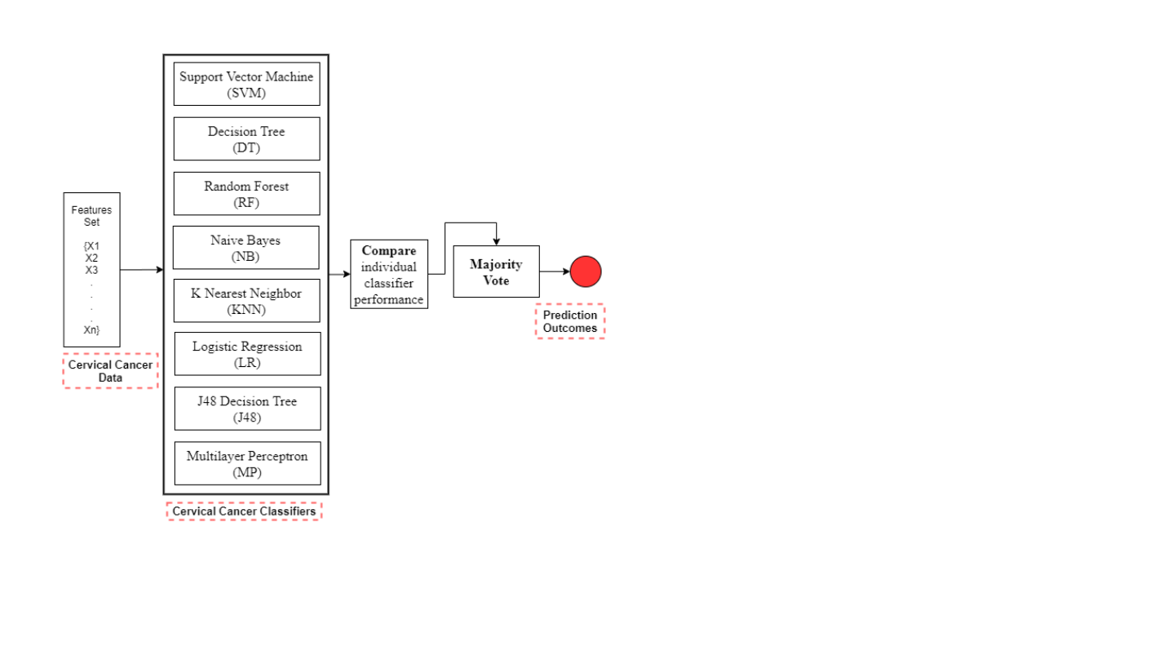An Enhanced Ensemble Diagnosis of Cervical Cancer A Pursuit of Machine Intelligence Towards Sustainable Health
Objective
The main objective of this application is to classify the cervical cancer disease(i.e. Whether the person is having cancer disease or not) using machine learning algorithms.
Abstract
Cervical cancer is a potentially
life-threatening disease marked by health practitioners. The late diagnosis and
treatment, being quite challenging, stake the precious lives of patients. In
both developed and undeveloped states, the formal screening for disease
identification suffers due to its medical cost, unavailable health facilities,
society norms, and late appearance of symptoms. Machine intelligence is
cost-effective, computationally inexpensive, and early diagnosis of several
types of diseases, including cervical cancer. The patients are not required to
pass through contemporary and tedious medical procedures, and early diagnosis
of cervical cancer is quite handy with machine-intelligent solutions. The
problem with the current machine classification methods for disease
identification is the reliance on a single classifier’s prediction accuracy.
The adoption of single classification methods doesn’t ensure the optimum
prediction due to bias, over-fitting, mishandling of noisy data, and outliers.
This research study proposes an Ensemble classification method based on
majority voting for an accurate diagnosis addressing the patient’s medical
conditions or symptoms. The study experiments a wide range of available
classifiers, namely Decision Tree (DT), Support Vector Machine (SVM), Random
Forest (RF), K-Nearest Neighbor (KNN), Naive Bayes (NB), Multiple Perceptron
(MP and Logistic Regression (LR) classifiers. The study records a significant
enhancement in prediction accuracy of 94% that outperforms the prediction
accuracies of single classification methods tested on the same bench marked
datasets. Thus, the proposed model bestows a second opinion to health
practitioners for disease identification and timely treatment.
KEYWORDS: Machine Learning Algorithms, Classifiers, Cervical Cancer, Ensemble Classification.
NOTE: Without the concern of our team, please don't submit to the college. This Abstract varies based on student requirements.
Block Diagram

Specifications
SYSTEM SPECIFICATIONS:
SOFTWARE CONFIGURATIONS:
Technology : Deep Learning, Python
Libraries using : Pandas, Matplotlib, NumPy, Scikit-learn
Version : Python 3.6
Platform : Stream lit
HARDWARE CONFIGURATIONS:
RAM : 8GB, 64 bit os.
Processor : I3/I5 Intel processor
Operating system : Windows 10 pro
Learning Outcomes
LEARNING OUTCOMES:
· Objective of the project .
· How Internet Works.
· What is a search engine and how browser can work.
· What type of technology versions are used .
· Working Procedure.
· Introduction to basic technologies used for.
· How project works.
· Input and Output modules .
· Frame work use.
· About python.
· About streamlit
· What are Deep learning algorithms.
· How can we identify and detect the fake reviews by using machine learning algorithms.
· What is meant by preprocessing.
· What are preprocessing techniques.
· How can we collect dataset.
· Practical exposure to
· Hardware and software tools.
· Solution providing for real time problems.
· Working with team/ individual.
· Work on Creative ideas.





 Paper Publishing
Paper Publishing
